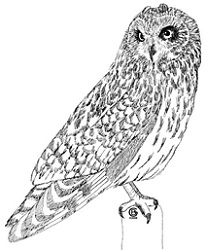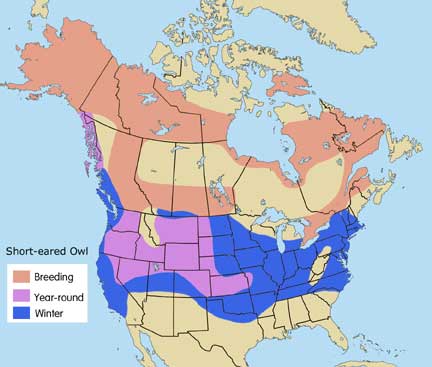
Scientific name: Asio flammeus
A tawny, mid-sized owl with a large, round head, long and narrow wings, and a tail of medium length. The upper body is mottled brown and buff, the underside is buff to reddish with vertical streaks. Sexes have similar plumage, but females tend to be darker and more heavily streaked. This owl has yellow eyes and a black bill, set in a large, whitish facial disc of feathers that help direct sound to the ears. Small “ear” tufts can be raised above the forehead in a defensive posture, but these are often not seen. Females are slightly larger than males, and this species is larger than its cousin the Long-eared Owl. The pattern of flight is irregular, with shallow, stiff wing beats; the wings have dark carpal patches and barred wing tips that are visible in flight.
Small, wide-set feather tufts often lead finders to think this is a “baby great horned owl”; large, yellow eyes; streaked underparts (w/ horizontal black barring in the juveniles changing to irregular vertical streaks in adult plumage); very well camouflaged for its day-time roosts against the trunks of trees; biggest of the little owls.
Male/Female
Length: 15″ ave.
Wingspan: 38″ ave.
Weight: 12 oz. ave.
State and federally protected.
A variety of open area habitats will support this species. These include marshes, grasslands, prairies, tundra, grassy coastal areas, and agricultural lands. Open country that will support cyclic populations of small mammals are the basic habitat requirement; mixed areas of woods and clearings may be used at times, as trees are sometimes used for roosting in winter.
Small mammals and insects are the main sources of food; birds are also sometimes taken, especially in coastal areas. This species is a diurnal and semi-nocturnal hunter, foraging during the day as well as at dawn and dusk. The most common hunting method is to search for prey by flying low over open ground, often hovering in the air before pouncing; they also hunt from a perch The Short-eared Owl hunts primarily by sound, but also by sight.
This owl is usually quiet, but during the breeding season males can be heard to give a voohoohoohoohoo call during courtship flights. Sometimes a call of keeee..ow may be given during the wintertime; a bark-like call is given if intruders approach a nest.
The Short-eared owl is a ground nester. Preferred nesting sites are mounds or ridges that give a slight elevation above surrounding terrain to guard against flooding. Finding a place with enough vegetation to hide a nesting female, this owl will scrape out a nest bowl in the ground and line it with grass and downy feathers for insulation.
Collisions with vehicles and flying into windows are frequent causes of injury for this owl, which is also vulnerable due to its ground nesting habits. Loss of open country habitat through development, agriculture, and grazing is a major problem.

The Short-eared Owl ranges in North America from Alaska, Canada, and the US, down as far as central Mexico. This species is migratory over the northern part of its range, moving south in winter.
Special Thanks for range maps:
Dan Gleason
BGleason Design & Illustration
Commercial & Scientific Illustration, Graphic Design
CraneDance Communications
Book Production/Design

